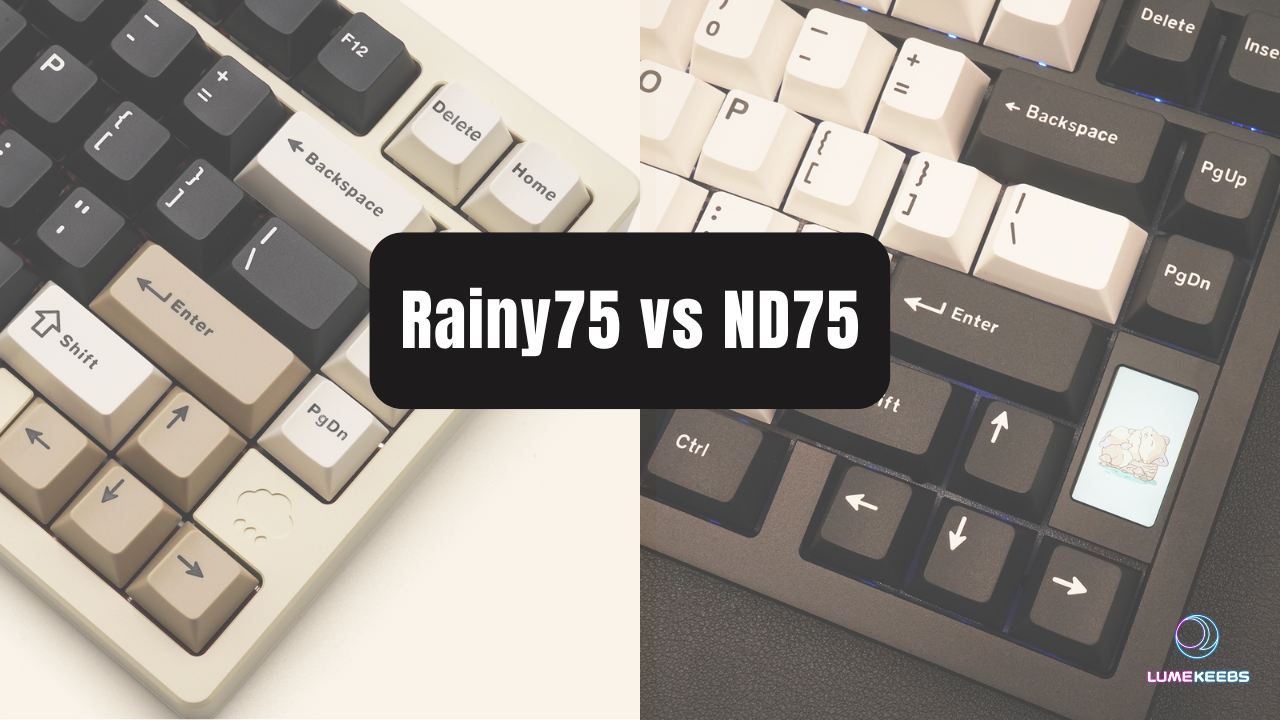Overview
The WOBKEY Rainy75 and the Chilkey ND75 are two of the most hyped prebuilt keyboards of 2024, and for a good reason. Both the Rainy75 and the ND75 are high quality prebuilt keyboards that sounds nice, feels nice, and also nice to our wallets. They are both priced around 100 USD and made with exceptional quality and with a plethora of features that was unheard of to have at this price point even just a couple years back.
Let's take a look at what the Rainy75 and the ND75 offer, and which one is the better match for you!
Product Details

Key Features
Both the Rainy75 and the ND75 have similar case aesthetics with the box-on-wedge design.
The Rainy75 has a cleaner looking bottom weight with their logo engraved into the bottom case as well different options for the weight finish, while the ND75 has only one option for the bottom weight which looks just looks like a brushed machining design.
The Rainy75 features different bottom weights depending on the version. The Lite Series features a gradient glass bottom weight, the Standard Series has the option for either a gradient glass or mirrored glass bottom weight, and the Pro series features a stone textured Silver SUS304 bottom weight.
On the top case, the Rainy75 has their logo above the right arrow key, while the ND75 has a screen module above the right arrow key.
The ND75 features a 2U vertical LCD screen module above the right arrow key that can be used to customize a variety of displays to match your personalized aesthetic, however the software is not very user friendly.
Keyboard Sound
The Rainy75 and the ND75 stock prebuilt form sound relatively similar as you would expect with the amount of foam in both of them. They both have the deep, creamy, and foamy sound signature straight out of the box. However the Rainy75 did appear to have a more refined sound than the ND75 in the stock configuration, most noticeably with the difference in their stock stabilizer tuning.
With all of the foams removed, both the Rainy75 and the ND75 have some case ping. However, the Rainy75 seemed to have slightly less ping and sounded slightly fuller than the ND75.
Both the Rainy75 and the ND75 come with factory lubed switches and good quality doubleshot PBT keycaps that sound great straight out of the box. In my opinion, the Rainy75 version that comes with HMX Violet switches sound the best since HMX switches tend to have excellent factory lube, minimal stem wobble, and a clean sound that can be clacky, creamy, or thocky depending on how the keyboard is configured.
For the ND75, here are our thoughts on the different mounting styles: the split o-ring mount seemed to sound the deepest and thockiest, the silica gel mount sounded the most open and creamy (similar to other gasket mounts), and the top mount sounded the most crispy and punchy especially on the spacebar.
Here is a sound test comparing the Rainy75 with the ND75:
Keyboard Feel
The Rainy75 is PCB gasket mounted while the ND75 could be mounted in 3 different configs with either split o-rings, silicone gel gaskets, or top mount.
Both the Rainy75 and the ND75 feel relatively similar in terms of flex in their stock form. They both have versions with flex cuts and their mounting systems have similar flex as well. Although there might be a more drastic difference between the two if all of the foam were removed and created more space within the keyboard case for the PCB/plate assembly to flex.
For the ND75, the split o-ring mount and the silica gel mount feel relatively similar while the top mount feels the most solid (feels like a top mount). All three mounting styles feel comfortable to type on and the best option is just personal preference. Good thing about the ND75 is that it has the quick assembly ball-catch mechanism so it'll be easier to play around with different configurations to find what works best for you.
Build Experience
Since both the Rainy75 and the ND75 come prebuilt, the initial build experience is mostly comprised of the unboxing and setup experience. Both keyboards are amazing to use straight out of the box, but for those who are interested in tinkering with different configs (keycaps, switches, mounting, etc) here are our thoughts on the build experiences for the Rainy75 and ND75.
The ND75 has a screwless quick assembly system using a ball-catch mechanism. This makes the ND75 incredibly easy to open to try out different configs since the ball-catch mechanism allows the top case to be unlatched from the bottom case without and unscrewing necessary. Whereas the Rainy75 is assembled with a hidden screw design on the edges of the case which makes it a little bit more time consuming to open up since it requires removing the switches that hide the screws and unscrewing the screws.
Both the Rainy75 and ND75 have flex cuts on their plate and PCBs. The Rainy75 has a flex cut plate as well as a per-key flex cut PCB. The ND75 has a flex cut plate and an option for either a 1.2mm flex cut PCB or 1.6mm non-flex cut. These flex cuts make inserting and removing switches more difficult. When trying to remove switches the plate/PCB assembly flexes up and when trying to insert switches the plate/PCB assembly flexes down which make it difficult to fully seat the switch. It is recommended to fully open the case and remove the plate/PCB assembly when swapping out switches to prevent any damage to PCB or keyboard components. We would also recommend to use a plate fork (or tweezers if no plate fork) to help support the flex cut plate when inserting switches.
Things to Note
For the Rainy75 the On/Off switch is underneath the caps lock key and for the ND75 the On/Off switch is underneath the right shift, so to turn on/off the wireless mode you would have to remove those respective keycaps.
Even though both of these keyboards have a hotswap PCB, which is meant to make swapping switches easy, it is highly recommended that you disassemble the keyboard to fully take out the PCB and support the back of the hotswap sockets to prevent any potential damage to the hotswap contact points or potential for the hotswap sockets popping out.
The adhesive on the case foam for the ND75 is really sticky and difficult to remove. If you plan to experiment with the foams in the ND75 be a little more careful when removing the case foam that is attached to the bottom of the PCB.
Software: The Rainy75 is compatible with QMK and VIA to customize your keys while the ND75 uses its own proprietary software to customize your keys.
Conclusion
Both the WOBKEY Rainy75 and the Chilkey ND75 are amazing options for a custom keyboard that sound and feel premium at a more affordable price.
There are several elements to consider between the Rainy75 and the ND75, like software compatibility, colors, typing angle, front height, and other features. But to simplify the choice, here are our thoughts.
Rainy75:
- If you are looking for a keyboard that you just want to use straight out of the box and not tinker with.
- If you are looking for softer colors for the keyboard case color.
- If you want QMK/VIA software compatibility.
ND75:
- If you are looking for a keyboard that you just want to use straight out of the box and not tinker with.
- If you are looking for a keyboard that you want to experiment with different configurations, like mountings styles, switches, foam, etc., then the ND75 would most likely be the best fit for you with their quick assembly ball-catch mechanism.
- If you are looking for more vibrant colors for your keyboard case color.
- If you want a non-flex cut PCB. The ND75 has both flex cut and non-flex cut PCB.
- If you want a screen module to customize.
You can find both keyboard in our shop (Rainy75 and ND75).
Other Reading
HMX Violet and JWK WOB | Rainy75 Switch Review
Holy Panda Tactile Switch Review
Gazzew Boba U4T Tactile Switch Review
Sarokeys Strawberry Wine V2 Linear Switch Review
HMX Cheese Linear Switch Review
HMX Macchiato Linear Switch Review
Cherry MX Black Clear Top "Nixie" Linear Switch Review
Durock Silent Switches Review | Dolphin, Shrimp, Daybreak Silent Switches


Share:
Top Linear Switches of 2024
Top Tactile Switches of 2024